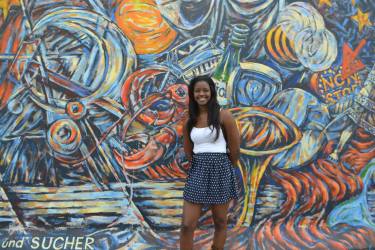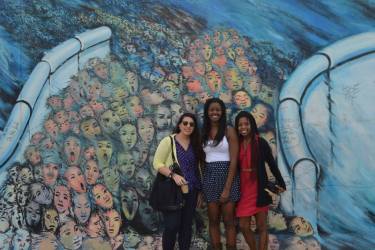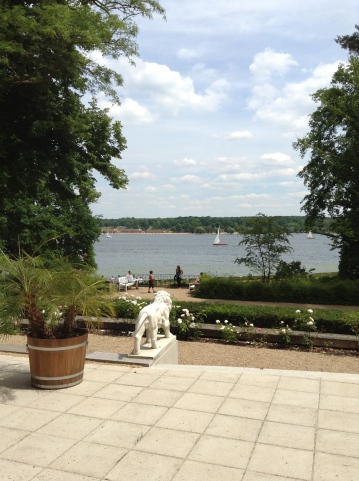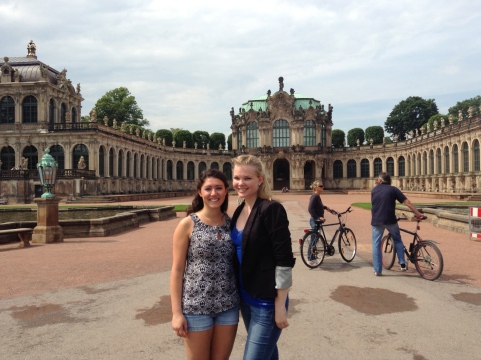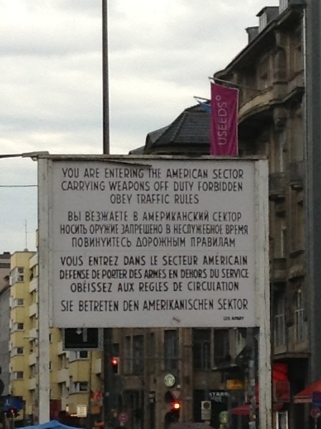
Checkpoint Charlie, Berlin
There is not much context when you learn about world history in high school, (especially if you don’t pay attention). Before I came to Europe and definitely before I started studying European politics in college, modern history, such as the Holocaust, the fall of the Berlin wall, etc. might as well have occurred around the same time as the Roman Empire. The times I listened rather than slept in Mr. Hill’s class (collectively not a whole lot), I basically lumped everything together time wise – World War I and II, imperialism, Nazis, communism, colonialism, etc. – and just labeled them all bad and incorrectly, of the past.
On the contrary, the tragedies that came under Hitler and Stalin were quite recent, and their continued impact pervades society in manifest ways. America has not seen warfare on our soil since the Civil War, so exploring a city with such visible and tangible history is fascinating. In Berlin in particular, pieces of the Berlin wall are scattered throughout the city in random places sometimes, often as a type of art.
A large portion of the Berlin Wall was left and made into an exhibit called the Mauer Memorial.
Further, a portion of the Wall stands along the River Spree displaying 105 murals painted and preserved on the east side of the Wall.

“Brother Kiss” by Russian artist Dimitri Vrubel, East Side Gallery”
The Berlin Wall fell in 1990 with the collapse of the Soviet Union, but as my German friend Cosima from East Germany put it, “It did not fall in the minds of some people.” What she meant is that although Germany reunified, East Germans and West Germans are still divided in terms of their perceptions of each other. Some West Germans consider East Germans ideologically behind since they spent so many years under repressive rule. In many regions, East Germans have a distinct accent that is often associated with being slow or ignorant, sort of like the Southern accent in the U.S. Although from the East, Cosima does not have this accent because her mom is an opera singer and made sure she learned “proper German,” as she called it.
When Cosima asked me what is the largest difference I find between Americans and Germans, I said it is our respective relationships with our nation’s history. Americans know and appreciate major figures and events like George Washington, the Boston Tea Party etc., but for Germans their personal connection to their history is manifested in the ways they talk, think, identify themselves, develop political opinions, perceive other people, etc. The racial divide in America before the American Civil War without a doubt still influences the American people, but Civil War battles are much more romanticized (indeed, they are reenacted for fun on Lookout Mountain) than is say, the Wannsee Conference house, where the details for the Final Solution were laid out by Hitler and his colleagues.
In fact, the sites of major bloody Civil War battles in my hometown of Chattanooga are my favorite places to take my visitors to relax and enjoy the springtime, while few Germans consider a visit to Sachsenhousen concentration camp a relaxing day.

Major Civil War “Battle Above the Clouds” site, Cravens House, TN
Versus:
The divisions brought by World War II and the Soviet Union are still felt today throughout Europe. Politicians who I spoke with from other countries still made comments such as, “the Germans need to have their power kept in check,” the Dutch still yell things at the German politicians like, “We want our bikes back!” and regarding German’s role in austerity measures in Greece, Greek newspapers publish cartoons of German Prime Minister Angela Merkel with Hitler’s moustache. Also noteworthy is how these things influence the German people.
I asked Cosima if the German people ever get tired of how cornered the rest of the world keeps them in international affairs following the Nazi era. She told me it is quite the opposite and talked about the German word Kollektivschuld, which describes the continued, collective guilt of German people for the atrocities committed by their ancestors. This is not something to which I can relate. There are many things about American history I think are quite terrible, but I do not place this on myself. By the same token, I am proud of my country, but do not feel like my history defines me. Germans are much more connected to their history.
As an example, I later was talking to Cosima over beers and described the “shoe testing track” I came across at Sachsenhousen concentration camp, on which prisoners were forced to walk for miles testing different military boot materials. I was very specific in my gruesome description, as I would have been if describing it to anyone who had not seen it: “The prisoners were forced to walk 18 miles a day.” They often times were given shoes that were not their size and developed terrible blisters.” etc. (See my post on Sachsenhousen.) Before I finished my story, I noticed her face turning rosy. She averted her eyes and replied, “Yes, that is one of the darker parts of our history.” I was kind of taken aback that she owned the story as her own, because I never associate the deeds of the Nazis with specific Germans, or Germany at all really. The Nazi atrocities were the acts of the ones who carried them out, not the responsibility of Cosima or the new Germany, in my mind. I responded that it was a darker part of human history.
Although discontent with the less reputable portions of Germany’s history, Cosima was contagiously admiring of her hometown of Dresden.
People joke (sort of) that Germans are known for their principled behavior nowadays because they are still trying to make up for World War II. Indeed, Germany is quite obliging to the rest of Europe financially, they avoid stepping on toes in military decisions, they are incredibly environment friendly, etc. One evening when Cosima’s friend stopped to remove a beer bottle from the path and add it to the recycle bin, she joked, “How German of him.”
The closeness of history to Germany is unambiguous in Berlin, where every other corner of the city has a memorial to some tragic or fantastic event. Further, as the people will tell you, German history is more than history; it is still a part of their very essence.
——
Special thanks to Cosima Olender for her contributions to this post.




